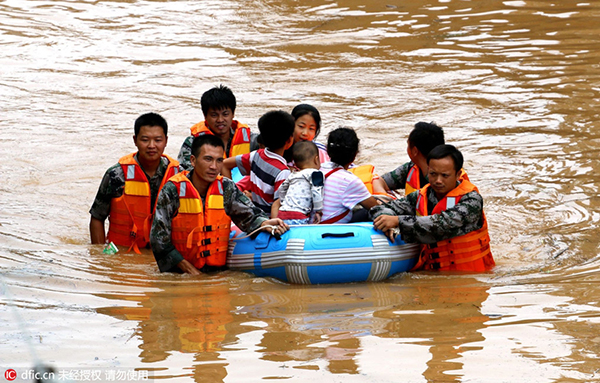High time to reduce costs of floods
Updated: 2016-07-27 07:54
By Dan Steinbock(China Daily)
|
||||||||
 |
|
Armed police rescue residents in Xiaxi village, Yutian town in South China's Jiangxi province on July 18, 2016.[Photo/IC] |
Weeks of torrential rain have caused a series of devastating floods in many parts of China. With economic losses soaring, the impact will be felt on GDP growth. The estimated loss of more than $44.7 billion makes this year's floods in China one of the costliest non-US weather disaster on record. Only the 1998 floods, which caused a loss of about $40 billion (at 2016 dollar rate), were the same damaging.
Economic growth is very sensitive to adverse impacts on roads, railways and supply disruptions, which can result in shortages. As transport infrastructure is paralyzed or impaired, factories close their doors in industrial provinces, along with offices in post-industrial cities.
Fruit and vegetable prices usually rise in flood-affected areas, where the government now closely monitors prices and implements price controls, if needed. In June, the consumer price index grew 1.9 percent year-on-year. Pork prices played a major role in annualized price increases, adding some 0.7 percentage points to the headline figure. This is not surprising as the seven provinces worst hit by the floods account for more than one-fourth of all hogs in China.
Flooding patterns reflect monsoon seasons. Heavy rains in China occur along the seasonal meiyu ("plum rains") front that extends from East China to the Pacific south of Japan. Associated with the southwest monsoon, these rains typically affect southeastern China from mid-May to mid-June and northern China during July and August.
Severe floods tend to have a substantial impact on agricultural output, which is reflected by the CPI, because of heavy food weightings in the inflation basket. Analysts anticipate flooding to raise consumer prices in July and August by 0.2 percentage points, which would cause price levels to exceed 2 percent.
Rainfalls are particularly heavy in the summer following an El-Niño event, as in 1998 and this summer. Seasonally, heavy rainfalls tend to amplify downside risks, which often have a negative impact on economic growth in the third quarter, unless the government chooses to intervene with stimulus measures.
- Four officials suspended after fatal floods
- Dam 'unsung hero' amid floods
- Emergency response to Shanxi floods
- Heavy rain, floods across China
- Rain keeps the floods coming
- Counting the costs of floods in China
- Coming-of-Age Day on the frontline of fighting floods
- Floods expose poor river management
- Revisiting history: Devastating floods of 1998
- Floods show need for responsible embankments

 It's Pokemon Go time in HK
It's Pokemon Go time in HK
 Daredevils brave record Shanghai skywalk
Daredevils brave record Shanghai skywalk
 Top 8 foreign sports stars endorsing Chinese brands
Top 8 foreign sports stars endorsing Chinese brands
 Chinese shows captivate audience at Afro-Chinese Arts Festival
Chinese shows captivate audience at Afro-Chinese Arts Festival
 Sunny images of 60-year-old go viral in China
Sunny images of 60-year-old go viral in China
 Xi'an battered by summer downpours
Xi'an battered by summer downpours
 Photographer uses traditional technique to capture images
Photographer uses traditional technique to capture images
 Now and then: Rebirth of Tangshan 40 years after quake
Now and then: Rebirth of Tangshan 40 years after quake
Most Viewed
Editor's Picks

|

|

|

|

|

|
Today's Top News
Ministry slams US-Korean THAAD deployment
Two police officers shot at protest in Dallas
Abe's blame game reveals his policies failing to get results
Ending wildlife trafficking must be policy priority in Asia
Effects of supply-side reform take time to be seen
Chinese State Councilor Yang Jiechi to meet Kerry
Chinese stocks surge on back of MSCI rumors
Liang avoids jail in shooting death
US Weekly

|

|







